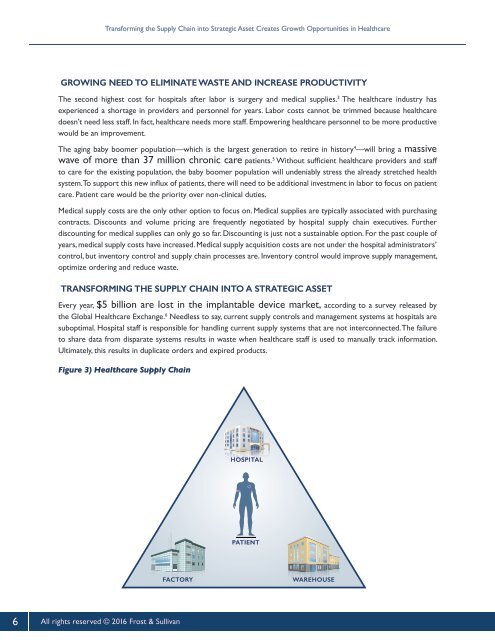FS_WP_CardinalHealth_040816_MC_v3
You also want an ePaper? Increase the reach of your titles
YUMPU automatically turns print PDFs into web optimized ePapers that Google loves.
H O S P I T A L<br />
Transforming the Supply Chain into Strategic Asset Creates Growth Opportunities in Healthcare<br />
GROWING NEED TO ELIMINATE WASTE AND INCREASE PRODUCTIVITY<br />
The second highest cost for hospitals after labor is surgery and medical supplies. 3 The healthcare industry has<br />
experienced a shortage in providers and personnel for years. Labor costs cannot be trimmed because healthcare<br />
doesn’t need less staff. In fact, healthcare needs more staff. Empowering healthcare personnel to be more productive<br />
would be an improvement.<br />
The aging baby boomer population—which is the largest generation to retire in history 4 —will bring a massive<br />
wave of more than 37 million chronic care patients. 5 Without sufficient healthcare providers and staff<br />
to care for the existing population, the baby boomer population will undeniably stress the already stretched health<br />
system. To support this new influx of patients, there will need to be additional investment in labor to focus on patient<br />
care. Patient care would be the priority over non-clinical duties.<br />
Medical supply costs are the only other option to focus on. Medical supplies are typically associated with purchasing<br />
contracts. Discounts and volume pricing are frequently negotiated by hospital supply chain executives. Further<br />
discounting for medical supplies can only go so far. Discounting is just not a sustainable option. For the past couple of<br />
years, medical supply costs have increased. Medical supply acquisition costs are not under the hospital administrators’<br />
control, but inventory control and supply chain processes are. Inventory control would improve supply management,<br />
optimize ordering and reduce waste.<br />
TRANSFORMING THE SUPPLY CHAIN INTO A STRATEGIC ASSET<br />
Every year, $5 billion are lost in the implantable device market, according to a survey released by<br />
the Global Healthcare Exchange. 6 Needless to say, current supply controls and management systems at hospitals are<br />
suboptimal. Hospital staff is responsible for handling current supply systems that are not interconnected. The failure<br />
to share data from disparate systems results in waste when healthcare staff is used to manually track information.<br />
Ultimately, this results in duplicate orders and expired products.<br />
Figure 3) Healthcare Supply Chain<br />
HOSPITAL<br />
PATIENT<br />
FACTORY<br />
WAREHOUSE<br />
6 All rights reserved © 2016 Frost & Sullivan


